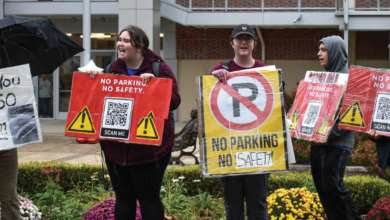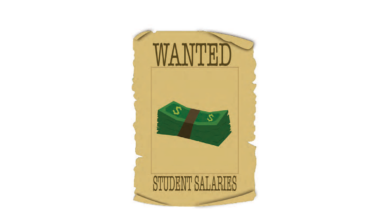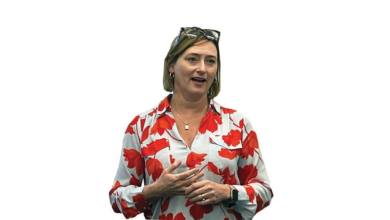COVID team not changing procedure for holiday break
By Shaun Chornobroff and Jeremy Hester
When Rider students gather around their tables surrounded by loved ones on Thanksgiving, enjoying all the holiday classics like turkey or a plate of stuffing, it will come with the realization that, unlike the year before, they will be returning to their dorm rooms that Sunday and attending class the following day on Nov. 29.
Despite discussions of moving to remote learning, Rider’s COVID-19 Implementation Team ultimately decided to complete the semester as they did pre-pandemic, according to Rider’s Vice President Initiatives and Planning and Secretary to the Board Debbie Stasolla.
“The COVID [protocol implementation] team did talk about [going remote],” said Stasolla, who is also one of the leaders of the implementation team. “But given the relatively low number of cases that we’ve been dealing with so far, and the fact that the majority of our students, faculty and staff are vaccinated, that we will be finishing out the semester like we typically do.”
How Other State Schools Have Faired
The university has staved off a massive outbreak of the virus thus far, only recording 40 positive cases of COVID-19 in the community as of Nov. 12, the last time the university’s weekly COVID-19 dashboard was updated. Of the 40 cases, 27 have come within Rider’s 4,730 person student population.
Theo Edgehill, a junior computer science major has been particularly pleased with the measures the university has taken this semester.
“I feel like they have done a lot to make sure the students have stayed safe,” said Edgehill. “And the mandate that we have to wear masks has been really helpful.”
Montclair State, another New Jersey institution with a student population of 20,022, has seen 176 positive cases in the fall semester among its student population as of Nov. 11, according to its dashboard.
Blake Montalto, a senior at Montclair, explained that students are encouraged to stay 6 feet apart when possible, required to keep their masks up and have to use an app called Hawk Check.
“Every morning before leaving the dorm … students are required to complete a survey that asks if we have any symptoms or if we have been in contact with COVID-19,” Montalto explained. “If we check any of those boxes it says we can’t enter campus, but I couldn’t tell you the last time someone asked to see if I completed it.”
Rider uses an app, similar to Hawk Check, called Campus Clear which describes itself as a “One-question daily self-survey that takes less than 10 seconds to complete.” Users are required to mark down any symptoms they may be experiencing, and depending on their answers, they are either greenlighted or told to go and isolate themselves.
When asked how he felt his college was handling in-person classes during the pandemic, Kieran Nashad, a senior at The College of New Jersey, simply replied “Poorly.”
TCNJ has had 11 confirmed COVID-19 cases in the past two weeks. He said that while the school requires students to be vaccinated and wear masks indoors, he wasn’t sure it was enough to actively prevent the COVID-19 virus from spreading.
“I see people pull [their masks] down all the time, especially in the gym. Mostly everyone wears masks, but a lot of them don’t wear them correctly,” Nashad said.
Nashad also mentioned that his school, which enrolls approximately 6,580 full-time students, has its daily self-check-up app, called TCNJ Roar.
“No one ever checks [the app]. I’ve only had to show somebody maybe one time, even though they told us at the beginning of the semester we need to fill it out every day,” Nashad said.
At Princeton University, administrators took a tougher approach transitioning away from online learning. The school had been working to ensure the safety of its 5,267 students, requiring students to take a weekly COVID-19 test. Of the 4,809 tests that were taken at Princeton in the week of Nov. 8, 16 came back positive for the virus.
Will history repeat itself ?
Rider’s website says that there are 36 states and two United States territories, along with 53 countries represented among its more than 4,500 person student population.
Bailey Adams, a sophomore environmental science major, is one of the students anxious about a potential rise in positive COVID-19 cases after the five-day holiday break.
“It makes me really nervous because I think there’s going to be a lot of travel. And I know there are some people who are unvaccinated, and they could be bringing things back to us,” Adams explained. “It doesn’t really even matter how cautious we are because we’re really doing all of these things for others. And if others aren’t doing it for us, we could be getting sick.”
When Thanksgiving Day was celebrated in 2020, New Jersey had a seven-day average of 4,887 positive cases, according to the Johns Hopkins University and Medicine Coronavirus Resource Center. Eleven days later, on Dec. 7, the seven-day average had grown to 5,784 cases.
Before students departed campus for the holiday the previous school year, the school offered COVID-19 tests to students, but will not be repeating the same practice this semester.
“When we offered this testing last year at Thanksgiving and at the end of the spring semester, testing wasn’t necessarily quite as widely available as it is now. So we were trying to facilitate that for our students. The circumstances are different now. There are plenty of pharmacies in the area or close to home where anyone could get tested,” Stasolla said.
Stasolla also explained that the implementation team will not be taking any extra precautions once students return on Nov. 28, saying that the team will be “standing by only doing weekly surveillance testing for unvaccinated students and employees.”
Despite not increasing testing before or after the holiday break, Stasolla knows that there is always a possibility of a rise in cases among the student population.
“I think there certainly is the possibility that we may see an uptick in cases as a result of not so much their travel, but the fact that they’re interacting now with other people, their families,” Stasolla said. “But think about it, some students have been probably interacting with their families anyway periodically throughout this semester. … But you’re right, probably as a result of the Thanksgiving Break, most of our students will be returning home for that holiday break, so I think we should expect the possibility of an increase in cases.”


